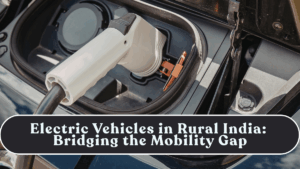While electric mobility in India often makes headlines for city-based launches and luxury EVs, the real revolution is happening elsewhere — in rural India. From small e-rickshaws to battery-powered two-wheelers and delivery carts, electric vehicles are silently transforming last-mile connectivity, affordability, and livelihoods in villages and small towns.

The Rural Shift Toward EV Mobility
As of 2025, India’s rural EV market accounts for nearly 40% of total EV sales, led by low-speed two-wheelers, e-rickshaws, and small commercial vehicles. These vehicles are bridging the connectivity gap where buses or autos are scarce and fuel prices unaffordable.
Drivers behind this rural EV boom include:
-
High Fuel Costs: Petrol and diesel have become too expensive for small-town commuters and transporters.
-
Government Subsidies: FAME-II incentives and state-level subsidies have made entry-level EVs affordable.
-
Entrepreneurial Opportunities: Rural youth are adopting EVs for delivery services, agriculture transport, and e-rickshaw rides.
-
Local Manufacturing: Indian companies like Kinetic Green, Omega Seiki, and Mahindra Last Mile Mobility are building EVs suited for rural roads.
Popular EV Types in Rural India
| Segment | Vehicle Type | Typical Range | Use Case |
|---|---|---|---|
| E-Rickshaw | 3-wheeler | 80–100 km | Passenger transport |
| E-Scooter | 2-wheeler | 60–120 km | Personal commute |
| Cargo EV | 3/4-wheeler | 100–150 km | Goods delivery & agriculture |
| Micro EV | Compact 4-wheeler | 150–200 km | Small town mobility |
Manufacturers are designing EVs that handle rough roads, high load capacity, and easy plug-in charging using local grids or even solar micro-stations.
How EVs Are Empowering Rural Economies
-
Employment Generation:
Thousands of villagers now earn through e-rickshaw driving, delivery, and repair services, boosting local income levels. -
Low Operating Costs:
Running costs as low as ₹1.2/km compared to ₹7/km for petrol vehicles allow higher profits for small transporters. -
Clean Energy Adoption:
In solar-friendly states like Rajasthan, Gujarat, and Uttar Pradesh, rural EVs are increasingly charged using solar power, creating a sustainable ecosystem. -
Accessibility for Women Entrepreneurs:
Women-led self-help groups (SHGs) are adopting EVs for small-scale delivery and logistics — an important step in financial inclusion and empowerment.
Government Policies Supporting Rural EV Penetration
The government’s push for “EVs for All” includes rural-specific programs such as:
-
PM E-Bus Seva and E-Vidya Mobility Mission — improving transport in remote regions.
-
FAME-II Scheme — subsidies for low-cost two- and three-wheelers.
-
Rural EV Infrastructure Plan (2024–2027) — installation of 25,000 rural charging points through state electricity boards.
-
Agricultural Mobility Electrification Policy (AMEP) — promoting e-tractors and farm mobility solutions.
States like Bihar, Uttar Pradesh, and Assam have rolled out separate grants for E-rickshaw registration, battery leasing, and women drivers.
Challenges in Rural EV Expansion
Despite strong momentum, challenges persist:
-
Charging Infrastructure Gaps: Few public chargers, reliance on household sockets.
-
Battery Recycling and Disposal: Lack of formal collection systems in smaller towns.
-
Awareness Barriers: Many buyers still view EVs as fragile or urban-focused.
-
Financing Hurdles: Rural credit institutions are slow to adopt EV loan models.
To overcome this, fintech startups like Revfin and Three Wheels United are providing micro-financing options for rural EV buyers, enabling faster adoption.
The Role of Solar and Microgrids
One of the most promising trends is solar-powered EV charging in villages. Local entrepreneurs are setting up solar microgrids that power multiple vehicles at once. In Rajasthan and Madhya Pradesh, cooperative-run charging hubs have reduced dependence on erratic grid electricity.
This decentralized approach aligns perfectly with India’s “Atmanirbhar Bharat” vision — promoting clean, self-reliant rural mobility.
The Future of Rural EV Adoption
By 2030, experts expect rural India to account for 50% of the country’s total EV sales. Future growth will come from:
-
Affordable lithium-iron-phosphate (LFP) batteries.
-
Swap-and-go battery systems.
-
Mini EV dealerships in Tier 3 and Tier 4 towns.
-
Public-private partnerships for local charging setups.
The trend is clear — India’s EV journey will be incomplete without its villages leading the charge.
Conclusion
The electric mobility story in India isn’t just urban — it’s grassroots. From solar-charged e-rickshaws to cargo EVs hauling farm produce, rural India is quietly electrifying transportation. As affordability improves and awareness grows, EVs will continue to bridge the mobility and income gap, empowering millions while driving India toward a cleaner future.
FAQs
Why are EVs gaining popularity in rural India?
Because they offer low operating costs, government subsidies, and better income opportunities for local drivers.
Which EVs are most common in rural areas?
E-rickshaws, scooters, and cargo EVs dominate due to affordability and practicality.
Are charging stations available in Indian villages?
Yes, rural charging infrastructure is expanding through solar-powered microgrids and public initiatives.
What challenges do rural EV owners face?
Limited financing, lack of awareness, and weak battery recycling networks remain key issues.
How do EVs impact rural livelihoods?
They create jobs, reduce transport costs, and support women entrepreneurs in last-mile mobility businesses.
